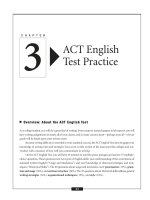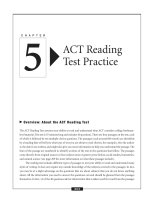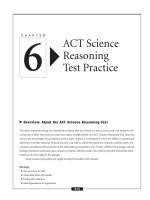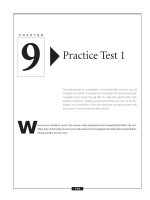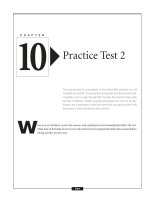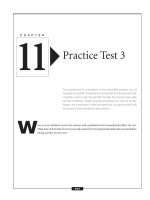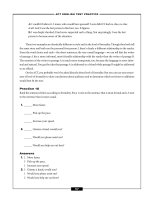ACT Math Test Practice
Bạn đang xem bản rút gọn của tài liệu. Xem và tải ngay bản đầy đủ của tài liệu tại đây (736.11 KB, 72 trang )
C H A P T E R
4
ACT Math Test
Practice
Over view: About the ACT Math Test
The 60-minute, 60-question ACT Math Test contains questions from six categories of subjects taught in most
high schools up to the start of 12th grade. The categories are listed below with the number of questions from
each category:
I
I
I
I
I
I
Pre-Algebra (14 questions)
Elementary Algebra (10 questions)
Intermediate Algebra (9 questions)
Coordinate Geometry (9 questions)
Plane Geometry (14 questions)
Trigonometry (4 questions)
Like the other tests of the ACT, the math test requires you to use your reasoning skills. Believe it or not,
this is good news, since it generally means that you do not need to remember every formula you were ever
131
– ACT MATH TEST PRACTICE –
taught in algebra class. You will, however, need a strong foundation in all the subjects listed on the previous
page in order to do well on the math test. You may use a calculator, but as you will be shown in the following lessons, many questions can be solved quickly and easily without a calculator.
Essentially, the ACT Math Test is designed to evaluate a student’s ability to reason through math problems. Students need to be able to interpret data based on information given and on their existing knowledge
of math. The questions are meant to evaluate critical thinking ability by correctly interpreting the problem,
analyzing the data, reasoning through possible conclusions, and determining the correct answer—the one
supported by the data presented in the question.
Four scores are reported for the ACT Math Test: Pre-Algebra/Elementary Algebra, Intermediate Algebra/Coordinate Geometry, Plane Geometry/Trigonometry, and the total test score.
Pretest
As you did with the English section, take the following pretest before you begin the math review in this chapter. The questions are the same type you will find on the ACT. When you are finished, check the answer key
on page 138 to assess your results. Your pretest score will help you determine in which areas you need the most
careful review and practice. For a glossary of math terms, refer to page 201 at the end of this chapter.
1. If a student got 95% of the questions on a 60-question test correct, how many questions did the student complete correctly?
a. 57
b. 38
c. 46
d. 53
e. 95
2. What is the smallest possible product for two integers whose sum is 26?
f. 25
g. 15
h. 154
i. 144
j. 26
132
– ACT MATH TEST PRACTICE –
3. What is the value of x in the equation −2x + 1 = 4(x + 3)?
a. − ᎏ6ᎏ
11
b. 2
11
c. − ᎏ6ᎏ
d. −9
e. − ᎏ3ᎏ
5
4. What is the y-intercept of the line 4y + 2x = 12?
f. 12
g. −2
h. 6
i. −6
j. 3
5. The height of the parallelogram below is 4.5 cm and the area is 36 sq cm. Find the length of side QR in
centimeters.
Q
R
4.5
P
a.
b.
c.
d.
e.
S
31.5 cm
8 cm
15.75 cm
9 cm
6 cm
6. Joey gave away half of his baseball card collection and sold one third of what remained. What fraction
of his original collection does he still have?
f.
2
ᎏᎏ
3
g.
1
ᎏᎏ
6
h. ᎏ1ᎏ
3
i.
1
ᎏᎏ
5
j.
2
ᎏᎏ
5
133
– ACT MATH TEST PRACTICE –
7. Simplify ͙40
ෆ.
a. 2͙10
ෆ
b. 4͙10
ෆ
c. 10͙4
ෆ
d. 5͙4
ෆ
e. 2͙20
ෆ
8. What is the simplified form of −(3x + 5)2?
f. 9x2 + 30x + 25
g. −9x2 − 25
h. 9x2 + 25
i. −9x2 − 30x − 25
j. −39x2 − 25
9. Find the measure of ∠RST in the triangle below.
T
111°
S
a.
b.
c.
d.
e.
2x°
x°
R
69
46
61
45
23
10. The area of a trapezoid is ᎏ1ᎏh(b1 + b2) where h is the altitude and b1 and b2 are the parallel bases. The
2
two parallel bases of a trapezoid are 3 cm and 5 cm and the area of the trapezoid is 28 sq cm. Find the
altitude of the trapezoid.
f. 14 cm
g. 9 cm
h. 19 cm
i. 1.9 cm
j. 7 cm
134
– ACT MATH TEST PRACTICE –
11. If 9m − 3 = −318, then 14m = ?
a. −28
b. −504
c. −329
d. −584
e. −490
12. What is the solution of the following equation? |x + 7| − 8 = 14
f. {−14, 14}
g. {−22, 22}
h. {15}
i. {−8, 8}
j. {−29, 15}
13. Which point lies on the same line as (2, −3) and (6, 1)?
a. (5, −6)
b. (2, 3)
c. (−1, 8)
d. (7, 2)
e. (4, 0)
14. In the figure below, MN = 3 inches and ෆM = 5 inches. Find the area of triangle MNP.
ෆෆ
Pෆ
P
5 in
N
3 in
M
f. 6 square inches
g. 15 square inches
h. 7.5 square inches
i. 12 square inches
j. 10 square inches
135
– ACT MATH TEST PRACTICE –
15. ෆC and are both radii of circle C and have a length of 6 cm. The measure of ∠ACB is 35°. Find the
Aෆ
BC
area of the shaded region.
B
35°
6c
m
A
C
a.
79
ᎏᎏπ
2
7
ᎏᎏπ
2
b.
c. 36π
d.
65
ᎏᎏπ
2
e. 4π
16. If f(x) = 3x + 2 and g(x) = −2x − 1, find f(g(x)).
f. x + 1
g. −6x − 1
h. 5x + 3
i. 2x2 − 4
j. −6x2 − 7x − 2
17. What is the value of log464?
a. 3
b. 16
c. 2
d. −4
e. 644
136
– ACT MATH TEST PRACTICE –
l
y=
mx
m
+b
18. The equation of line l is y = mx + b. Which equation is line m?
f. y = −mx
g. y = −x + b
h. y = 2mx + b
i. y = ᎏ1ᎏmx − b
2
j. y = −mx + b
19. If Mark can mow the lawn in 40 minutes and Audrey can mow the lawn in 50 minutes, which equation can be used to determine how long it would take the two of them to mow the lawn together?
a.
b.
c.
40
50
ᎏᎏ + ᎏᎏ = 1
x
x
x
x
ᎏᎏ + ᎏᎏ = 1
40
50
1
1
ᎏᎏ + ᎏᎏ = 90
x
x
d. 50x + 40x = 1
e. 90x = ᎏ1ᎏ
x
20. If sinθ = ᎏ2ᎏ, find cosθ.
5
f.
5
ᎏᎏ
21
g.
Ίᎏ5ᎏ
21
h. ᎏ5ᎏ
3
i.
3
ᎏᎏ
5
j.
Ίᎏᎏ
21
5
137
– ACT MATH TEST PRACTICE –
Pretest Answers and Explanations
1. Choice a is correct. Multiply 60 by the decimal equivalent of 95% (0.95). 60 × 0.95 = 57.
2. Choice f is correct. Look at the pattern below.
Product
Sum
1 + 25
25
2 + 24
48
3 + 23
69
4 + 22
88
5 + 21
105
The products continue to get larger as the pattern progresses. The smallest possible product is 1 × 25 =
25.
3. Choice c is correct. Distribute the 4, then isolate the variable.
−2x + 1 = 4(x + 3)
−2x + 1 = 4x + 12
1 = 6x + 12
−11 = 6x
11
−ᎏ6ᎏ = x
4. Choice j is correct. Change the equation into y = mx + b format.
4y + 2x = 12
4y = − 2x + 12
y = − ᎏ1ᎏx + 3
2
The y-intercept is 3.
5. Choice b is correct. To find the area of a parallelogram, multiply the base times the height.
A = bh
Substitute in the given height and area:
36 = b(4.5)
8=b
Then, solve for the base.
The base is 8 cm.
6. Choice h is correct. After Joey sold half of his collection, he still had half left. He sold one third of the
half that he had left (ᎏ1ᎏ × ᎏ1ᎏ = ᎏ1ᎏ), which is ᎏ1ᎏ of the original collection. In total, he gave away ᎏ1ᎏ and sold
3
2
6
6
2
1
2
1
1
3
1
4
2
2
ᎏᎏ, which is a total of ᎏᎏ of the collection (ᎏᎏ + ᎏᎏ = ᎏᎏ + ᎏᎏ = ᎏᎏ = ᎏᎏ). Since he has gotten rid of ᎏᎏ of the col6
3
2
6
6
6
6
3
3
lection, ᎏ1ᎏ remains.
3
7. Choice a is correct. Break up 40 into a pair of factors, one of which is a perfect square.
40 = 4 × 10.
͙40 = ͙4 ͙10 = 2͙10
ෆ
ෆ ෆ
ෆ.
138
– ACT MATH TEST PRACTICE –
8. Choice i is correct.
−(3x + 5)2 = −(3x + 5)(3x + 5)
−(3x + 5)(3x + 5)
−(9x2 + 15x + 15x + 25)
−(9x2 + 30x + 25)
−9x2 − 30x − 25
9. Choice b is correct. Recall that the sum of the angles in a triangle is 180°.
180 = 111 + 2x + x
180 = 111 + 3x
69 = 3x
23 = x
The problem asked for the measure of ∠RST which is 2x. Since x is 23, 2x is 46°.
10. Choice j is correct. Substitute the given values into the equation and solve for h.
A = ᎏ1ᎏh(b1 + b2)
2
28 = ᎏ1ᎏh(3 + 5)
2
28 = ᎏ1ᎏh(8)
2
28 = 4h
h=7
The altitude is 7 cm.
11. Choice e is correct. Solve the first equation for m.
9m − 3 = −318
9m = −315
m = −35
Then, substitute value of m in 14m.
14(−35) = −490
12. Choice j is correct.
|x + 7| − 8 = 14
|x +7| = 22
|22| and |−22| both equal 22. Therefore, x + 7 can be 22 or −22.
x + 7 = 22
x = 15
{−29, 15}
x + 7 = −22
x = −29
139
– ACT MATH TEST PRACTICE –
13. Choice d is correct. Find the equation of the line containing (2, −3) and (6, 1). First, find the slope.
y2 − y1
ᎏᎏ
x2 − x1
1−
ᎏ
= ᎏ(−3) = ᎏ4ᎏ = 1
6−2
4
Next, find the equation of the line.
y − y1 = m(x − x1)
y − 1 = 1(x − 6)
y−1=x−6
y=x−5
Substitute the ordered pairs into the equations. The pair that makes the equation true is on the line.
When (7, 2) is substituted into y = x − 5, the equation is true.
5 = 7 − 2 is true.
14. Choice f is correct. Triangle MNP is a 3-4-5 right triangle. The height of the triangle is 4 and the base
b
ᎏ
is 3. To find the area use the formula A = ᎏ2h .
(3)
12
ᎏ
A = ᎏ2(4) = ᎏ2ᎏ = 6.
The area of the triangle is 6 square inches.
15. Choice d is correct. Find the total area of the circle using the formula A = πr 2.
A = π(6)2 = 36π
A circle has a total of 360°. In the circle shown, 35° are NOT shaded, so 325° ARE shaded.
3 5
The fraction of the circle that is shaded is ᎏ2ᎏ. Multiply this fraction by the total area to find the shaded
360
area.
36π
ᎏᎏ
1
3 5
11,700π
65π
× ᎏ2ᎏ = ᎏ6ᎏ = ᎏ2ᎏ.
360
3 0
16. Choice g is correct.
f(g(x)) = f(−2x − 1)
Replace every x in f(x) with (−2x − 1).
f(g(x)) = 3(−2x − 1) + 2
f(g(x)) = −6x − 3 + 2
f(g(x)) = −6x − 1
17. Choice a is correct; log464 means 4? = 64; 43 = 64. Therefore, log464 = 3.
18. Choice j is correct. The lines have the same y-intercept (b). Their slopes are opposites. So, the slope of
the first line is m, thus, the slope of the second line is −m.
Since the y-intercept is b and the slope is −m, the equation of the line is y = −mx + b.
140
– ACT MATH TEST PRACTICE –
19. Choice b is correct. Use the table below to organize the information.
RATE
TIME
WORK DONE
Mark
1
ᎏᎏ
40
x
x
ᎏᎏ
40
Audrey
1
ᎏᎏ
50
x
x
ᎏᎏ
50
Mark’s rate is 1 job in 40 minutes. Audrey’s rate is 1 job in 50 minutes. You don’t know how long it will
take them together, so time is x. To find the work done, multiply the rate by the time.
Add the work done by Mark with the work done by Audrey to get 1 job done.
x
ᎏᎏ
40
+ ᎏxᎏ = 1 is the equation.
50
20. Choice g is correct. Use the identity sin2θ + cos2θ = 1 to find cosθ.
sin2θ + cos2θ = 1
(ᎏ2ᎏ)2 + cos2θ = 1
5
4
ᎏᎏ
25
+ cos2θ = 1
21
cos2θ = ᎏᎏ
25
cosθ =
͙21
ෆ
ᎏ
5
Lessons and Practice Questions
Familiarizing yourself with the ACT before taking the test is a great way to improve your score. If you are
familiar with the directions, format, types of questions, and the way the test is scored, you will be more comfortable and less anxious. This section contains ACT math test-taking strategies, information, and practice
questions and answers to apply what you learn.
The lessons in this chapter are intended to refresh your memory. The 80 practice questions following
these lessons contain examples of the topics covered here as well as other various topics you may see on the
official ACT Assessment. If in the course of solving the practice questions you find a topic that you are not
familiar with or have simply forgotten, you may want to consult a textbook for additional instruction.
Types of Math Questions
Math questions on the ACT are classified by both topic and skill level. As noted earlier, the six general topics
covered are:
Pre-Algebra
Elementary Algebra
Intermediate Algebra
141
Tips
• The math questions start easy and get harder. Pace yourself accordingly.
• Study wisely. The number of questions involving various algebra topics is significantly higher than
the number of trigonometry questions. Spend more time studying algebra concepts.
• There is no penalty for wrong answers. Make sure that you answer all of the questions, even if
some answers are only a guess.
• If you are not sure of an answer, take your best guess. Try to eliminate a couple of the answer
choices.
• If you skip a question, leave that question blank on the answer sheet and return to it when you
are done. Often, a question later in the test will spark your memory about the answer to a question that you skipped.
• Read carefully! Make sure you understand what the question is asking.
• Use your calculator wisely. Many questions are answered more quickly and easily without a calculator.
• Most calculators are allowed on the test. However, there are some exceptions. Check the ACT
website (ACT.org) for specific models that are not allowed.
• Keep your work organized. Number your work on your scratch paper so that you can refer back
to it while checking your answers.
• Look for easy solutions to difficult problems. For example, the answer to a problem that can be
solved using a complicated algebraic procedure may also be found by “plugging” the answer
choices into the problem.
• Know basic formulas such as the formulas for area of triangles, rectangles, and circles. The
Pythagorean theorem and basic trigonometric functions and identities are also useful, and not that
complicated to remember.
Coordinate Geometry
Plane Geometry
Trigonometry
In addition to these six topics, there are three skill levels: basic, application, and analysis. Basic problems
require simple knowledge of a topic and usually only take a few steps to solve. Application problems require
knowledge of a few topics to complete the problem. Analysis problems require the use of several topics to
complete a multi-step problem.
The questions appear in order of difficulty on the test, but topics are mixed together throughout the test.
Pre-Algebra
Topics in this section include many concepts you may have learned in middle or elementary school, such as
operations on whole numbers, fractions, decimals, and integers; positive powers and square roots; absolute
142
– ACT MATH TEST PRACTICE –
value; factors and multiples; ratio, proportion, and percent; linear equations; simple probability; using charts,
tables, and graphs; and mean, median, mode, and range.
N UMBERS
I
I
I
I
Whole numbers Whole numbers are also known as counting numbers: 0, 1, 2, 3, 4, 5, 6, . . .
Integers Integers are both positive and negative whole numbers including zero: . . . −3, −2, −1, 0, 1,
2, 3 . . .
Rational numbers Rational numbers are all numbers that can be written as fractions (ᎏ2ᎏ), terminating
3
decimals (.75), and repeating decimals (.666 . . . )
Irrational numbers Irrational numbers are numbers that cannot be expressed as terminating or
ෆ
repeating decimals: π or ͙2.
O RDER
OF
O PERATIONS
Most people remember the order of operations by using a mnemonic device such as PEMDAS or Please
Excuse My Dear Aunt Sally. These stand for the order in which operations are done:
Parentheses
Exponents
Multiplication
Division
Addition
Subtraction
Multiplication and division are done in the order that they appear from left to right. Addition and subtraction work the same way—left to right.
Parentheses also include any grouping symbol such as brackets [ ], braces { }, or the division bar.
Examples
1. −5 + 2 × 8
2. 9 + (6 + 2 × 4) − 32
Solutions
1. −5 + 2 × 8
−5 + 16
11
143
– ACT MATH TEST PRACTICE –
2. 9 + (6 + 2 × 4) − 32
9 + (6 + 8) − 32
9 + 14 − 9
23 − 9
14
F RACTIONS
Addition of Fractions
To add fractions, they must have a common denominator. The common denominator is a common multiple of the denominators. Usually, the least common multiple is used.
Example
1
2
ᎏᎏ + ᎏᎏ
3
7
1
ᎏᎏ × ᎏᎏ)
(3 7
7
2
ᎏᎏ
21
+
(ᎏ2ᎏ
7
×
3
ᎏᎏ)
3
+ ᎏ6ᎏ = ᎏ8ᎏ
21
21
The least common denominator for 3 and 7 is 21.
Multiply the numerator and denominator of each fraction by the same
number so that the denominator of each fraction is 21.
Add the numerators and keep the denominators the same. Simplify the
answer if necessary.
Subtraction of Fractions
Use the same method for multiplying fractions, except subtract the numerators.
Multiplication of Fractions
Multiply numerators and multiply denominators. Simplify the answer if necessary.
Example
3
ᎏᎏ
4
× ᎏ1ᎏ = ᎏ3ᎏ
20
5
Division of Fractions
Take the reciprocal of (flip) the second fraction and multiply.
1
ᎏᎏ
3
÷ ᎏ3ᎏ = ᎏ1ᎏ × ᎏ4ᎏ = ᎏ4ᎏ
4
3
3
9
144
ACT MATH TEST PRACTICE
Examples
1.
1
3
+ 2
5
2.
9
10
3.
4
5
ì 7
8
4.
3
4
ữ 6
7
3
4
Solutions
1.
1ì5
2ì3
+ ᎏᎏ
3×5
5×3
5
6
11
ᎏᎏ + ᎏᎏ = ᎏᎏ
15
15
15
2.
9×2
3×5
ᎏ× 2 − ᎏᎏ
10 ᎏ 4 × 5
3
18
15
ᎏᎏ − ᎏᎏ = ᎏᎏ
20
20
20
3.
4
ᎏᎏ
5
28
× ᎏ7ᎏ = ᎏᎏ = ᎏ7ᎏ
10
8
40
4.
3
ᎏᎏ
4
21
× ᎏ7ᎏ = ᎏᎏ = ᎏ7ᎏ
6
24
8
E XPONENTS
AND
S QUARE R OOTS
An exponent tells you how many times to the base is used as factor. Any base to the power of zero is one.
Example
140 = 1
53 = 5 × 5 × 5 = 125
34 = 3 × 3 × 3 × 3 = 81
112 = 11 × 11 = 121
Make sure you know how to work with exponents on the calculator that you bring to the test. Most scientific calculators have a yx or xy button that is used to quickly calculate powers.
When finding a square root, you are looking for the number that when multiplied by itself gives you
the number under the square root symbol.
͙25 = 5
ෆ
ෆ
͙64 = 8
ෆ
͙169 = 13
145
– ACT MATH TEST PRACTICE –
Have the perfect squares of numbers from 1 to 13 memorized since they frequently come up in all types
of math problems. The perfect squares (in order) are:
1, 4, 9, 16, 25, 36, 49, 64, 81, 100, 121, 144, 169.
A BSOLUTE VALUE
The absolute value is the distance of a number from zero. For example, |−5| is 5 because −5 is 5 spaces from
zero. Most people simply remember that the absolute value of a number is its positive form.
|−39| = 39
|92| = 92
|−11| = 11
|987| = 987
FACTORS
AND
M ULTIPLES
Factors are numbers that divide evenly into another number. For example, 3 is a factor of 12 because it divides
evenly into 12 four times.
6 is a factor of 66
9 is a factor of 27
−2 is a factor of 98
Multiples are numbers that result from multiplying a given number by another number. For example,
12 is a multiple of 3 because 12 is the result when 3 is multiplied by 4.
66 is a multiple of 6
27 is a multiple of 9
98 is a multiple of −2
R ATIO , P ROPORTION ,
AND
P ERCENT
Ratios are used to compare two numbers and can be written three ways. The ratio 7 to 8 can be written 7:8,
7
ᎏᎏ, or in the words “7 to 8.”
8
2
Proportions are written in the form ᎏ5ᎏ = ᎏxᎏ. Proportions are generally solved by cross-multiplying (mul25
tiply diagonally and set the cross-products equal to each other). For example,
= ᎏxᎏ
25
(2)(25) = 5x
50 = 5x
10 = x
2
ᎏᎏ
5
146
– ACT MATH TEST PRACTICE –
Percents are always “out of 100.” 45% means 45 out of 100. It is important to be able to write percents
as decimals. This is done by moving the decimal point two places to the left.
45% = 0.45
3% = 0.03
124% = 1.24
0.9% = 0.009
P ROBABILITY
The probability of an event is P(event) =
favorable
ᎏ.
For example, the probability of rolling a 5 when rolling a 6-sided die is ᎏ1ᎏ, because there is one favor6
able outcome (rolling a 5) and there are 6 possible outcomes (rolling a 1, 2, 3, 4, 5, or 6). If an event is impossible, it cannot happen, the probability is 0. If an event definitely will happen, the probability is 1.
C OUNTING P RINCIPLE
AND
T REE D IAGRAMS
The sample space is a list of all possible outcomes. A tree diagram is a convenient way of showing the sample
space. Below is a tree diagram representing the sample space when a coin is tossed and a die is rolled.
Coin
H
T
Die
1
2
3
4
5
6
1
2
3
4
5
6
Outcomes
H1
H2
H3
H4
H5
H6
T1
T2
T3
T4
T5
T6
The first column shows that there are two possible outcomes when a coin is tossed, either heads or tails.
The second column shows that once the coin is tossed, there are six possible outcomes when the die is rolled,
numbers 1 through 6. The outcomes listed indicate that the possible outcomes are: getting a heads, then
rolling a 1; getting a heads, then rolling a 2; getting a heads, then rolling a 3; etc. This method allows you to
clearly see all possible outcomes.
Another method to find the number of possible outcomes is to use the counting principle. An example
of this method is on the following page.
147
– ACT MATH TEST PRACTICE –
Nancy has 4 pairs of shoes, 5 pairs of pants, and 6 shirts. How many different outfits can she
make with these clothes?
Shoes
4 choices
Pants
5 choices
Shirts
6 choices
To find the number of possible outfits, multiply the number of choices for each item.
4 × 5 × 6 = 120
She can make 120 different outfits.
Helpful Hints about Probability
I
I
I
If an event is certain to occur, the probability is 1.
If an event is certain NOT to occur, the probability is 0.
If you know the probability of all other events occurring, you can find the probability of the remaining
event by adding the known probabilities together and subtracting that sum from 1.
M EAN , M EDIAN , M ODE ,
AND
R ANGE
Mean is the average. To find the mean, add up all the numbers and divide by the number of items.
Median is the middle. To find the median, place all the numbers in order from least to greatest. Count
to find the middle number in this list. Note that when there is an even number of numbers, there will be two
middle numbers. To find the median, find the average of these two numbers.
Mode is the most frequent or the number that shows up the most. If there is no number that appears
more than once, there is no mode.
The range is the difference between the highest and lowest number.
Example
Using the data 4, 6, 7, 7, 8, 9, 13, find the mean, median, mode, and range.
Mean: The sum of the numbers is 54. Since there are seven numbers, divide by 7 to find the
mean. 54 ÷ 7 = 7.71.
Median: The data is already in order from least to greatest, so simply find the middle number. 7 is the middle number.
Mode: 7 appears the most often and is the mode.
Range: 13 − 4 = 9.
148
– ACT MATH TEST PRACTICE –
L INEAR E QUATIONS
An equation is solved by finding a number that is equal to an unknown variable.
Simple Rules for Working with Equations
1. The equal sign separates an equation into two sides.
2. Whenever an operation is performed on one side, the same operation must be performed on the other
side.
3. Your first goal is to get all of the variables on one side and all of the numbers on the other.
4. The final step often will be to divide each side by the coefficient, leaving the variable equal to a
number.
C ROSS -M ULTIPLYING
You can solve an equation that sets one fraction equal to another by cross-multiplication. Crossmultiplication involves setting the products of opposite pairs of terms equal.
Example
x
ᎏᎏ
6
x + 10
= ᎏᎏ becomes 12x = 6(x) + 6(10)
12
12x = 6x + 60
−6x
−6x
6x
60
ᎏ ᎏ = ᎏᎏ
6
6
Thus, x = 10
Checking Equations
To check an equation, substitute the number equal to the variable in the original equation.
Example
To check the equation from the previous page, substitute the number 10 for the variable x.
x
x + 10
ᎏᎏ = ᎏᎏ
6
12
10
10 + 10
ᎏᎏ = ᎏ ᎏ
6
12
10
20
ᎏᎏ = ᎏᎏ
6
12
Simplify the fraction on the right by dividing the numerator and denominator by 2.
10
ᎏᎏ
6
10
= ᎏ6ᎏ
Because this statement is true, you know the answer x = 10 is correct.
149
– ACT MATH TEST PRACTICE –
Special Tips for Checking Equations
1. If time permits, be sure to check all equations.
2. Be careful to answer the question that is being asked. Sometimes, this involves solving for a variable
and than performing an operation.
Example: If the question asks for the value of x − 2, and you find x = 2, the answer is not 2, but
2 − 2. Thus, the answer is 0.
C HARTS , TABLES ,
AND
G RAPHS
The ACT Math Test will assess your ability to analyze graphs and tables. It is important to read each graph
or table very carefully before reading the question. This will help you to process the information that is presented. It is extremely important to read all of the information presented, paying special attention to headings and units of measure. Here is an overview of the types of graphs you will encounter:
I
CIRCLE GRAPHS or PIE CHARTS
This type of graph is representative of a whole and is usually divided into percentages. Each section of the
chart represents a portion of the whole, and all of these sections added together will equal 100% of the
whole.
Attendance at a Baseball Game
15%
girls
61%
adults
BAR GRAPHS
Bar graphs compare similar things with bars of different length, representing different values. These graphs
may contain differently shaded bars used to represent different elements. Therefore, it is important to pay
attention to both the size and shading of the graph.
Fruit Ordered by Grocer
100
Pounds Ordered
I
24%
boys
Key
Apples
Peaches
Bananas
80
60
40
20
0
Week 1
Week 2
150
Week 3
– ACT MATH TEST PRACTICE –
I
BROKEN LINE GRAPHS
Broken-line graphs illustrate a measurable change over time. If a line is slanted up, it represents an
increase, whereas a line sloping down represents a decrease. A flat line indicates no change.
In the line graph below, Lisa’s progress riding her bike is graphed. From 0 to 2 hours, Lisa moves
1
steadily. Between 2 and 2ᎏ2ᎏ hours, Lisa stops (flat line). After her break, she continues again but at a slower
pace (line is not as steep as from 0 to 2 hours).
Distance Travelled in Miles
Lisa’s Progress
50
40
30
20
10
0
1
4
2
3
Time in Hours
Elementary Algebra
Elementary algebra covers many topics typically covered in an Algebra I course. Topics include operations on
polynomials; solving quadratic equations by factoring; linear inequalities; properties of exponents and square
roots; using variables to express relationships; and substitution.
O PERATIONS
ON
P OLYNOMIALS
Combining Like Terms: terms with the same variable and exponent can be combined by adding the coefficients
and keeping the variable portion the same.
For example,
4x2 + 2x − 5 + 3x2 − 9x + 10 =
7x2 − 7x + 5
Distributive Property: multiply all the terms inside the parentheses by the term outside the parentheses.
7(2x − 1) = 14x − 7
S OLVING Q UADRATIC E QUATIONS
BY
FACTORING
Before factoring a quadratic equation to solve for the variable, you must set the equation equal to zero.
x2 − 7x = 30
x2 − 7x − 30 = 0
151
– ACT MATH TEST PRACTICE –
Next, factor.
(x + 3)(x − 10) = 0
Set each factor equal to zero and solve.
x+3=0
x = −3
x − 10 = 0
x = 10
The solution set for the equation is {−3, 10}.
S OLVING I NEQUALITIES
Solving inequalities is the same as solving regular equations, with one exception. The exception is that when
multiplying or dividing by a negative, you must change the inequality symbol.
For example,
−3x < 9
−3x
ᎏᎏ
−3
< ᎏ9ᎏ
−3
x > −3
Notice that the inequality switched from less than to greater than after division by a negative.
When graphing inequalities on a number line, recall that < and > use open dots and ≤ and ≥ use solid
dots.
x<2
0
P ROPERTIES
OF
1
2
x≤2
3
4
0
E XPONENTS
When multiplying, add exponents.
x 3 · x 5 = x 3+5 = x 8
When dividing, subtract exponents.
x7
ᎏᎏ
x2
= x7−2 = x5
When calculating a power to a power, multiply.
(x 6)3 = x 6·3 = x18
152
1
2
3
4
– ACT MATH TEST PRACTICE –
Any number (or variable) to the zero power is 1.
50 = 1
m0 = 1
9,837,4750 = 1
Any number (or variable) to the first power is itself.
51 = 5
m1 = m
9,837,4751 = 9,837,475
R OOTS
1
3
1
Recall that exponents can be used to write roots. For example, ͙x = x ᎏ2ᎏ and ͙x = x ᎏ3ᎏ. The denominator is
ෆ
ෆ
3
4
5
4 = x ᎏ3ᎏ and ͙x5 = x ᎏ2ᎏ. The properties of expox
ෆ
the root. The numerator indicates the power. For example, (͙ෆ)
nents outlined above apply to fractional exponents as well.
U SING VARIABLES
TO
E XPRESS R ELATIONSHIPS
The most important skill needed for word problems is being able to use variables to express relationships.
The following will assist you in this by giving you some common examples of English phrases and their mathematical equivalents.
I
I
I
I
I
I
“Increase” means add.
Example
A number increased by five = x + 5.
“Less than” means subtract.
Example
10 less than a number = x − 10.
“Times” or “product” means multiply.
Example
Three times a number = 3x.
“Times the sum” means to multiply a number by a quantity.
Example
Five times the sum of a number and three = 5(x + 3).
Two variables are sometimes used together.
Example
A number y exceeds five times a number x by ten.
y = 5x + 10
Inequality signs are used for “at least” and “at most,” as well as “less than” and “more than.”
Examples
The product of x and 6 is greater than 2.
x×6>2
153
– ACT MATH TEST PRACTICE –
When 14 is added to a number x, the sum is less than 21.
x + 14 < 21
The sum of a number x and four is at least nine.
x+4≥9
When seven is subtracted from a number x, the difference is at most four.
x−7≤4
A SSIGNING VARIABLES
IN
W ORD P ROBLEMS
It may be necessary to create and assign variables in a word problem. To do this, first identify an unknown
and a known. You may not actually know the exact value of the “known,” but you will know at least something about its value.
Examples
Max is three years older than Ricky.
Unknown = Ricky’s age = x
Known = Max’s age is three years older
Therefore,
Ricky’s age = x and Max’s age = x + 3
Siobhan made twice as many cookies as Rebecca.
Unknown = number of cookies Rebecca made = x
Known = number of cookies Siobhan made = 2x
Cordelia has five more than three times the number of books that Becky has.
Unknown = the number of books Becky has = x
Known = the number of books Cordelia has = 3x + 5
S UBSTITUTION
When asked to substitute a value for a variable, replace the variable with the value.
Example
Find the value of x2 + 4x − 1, for x = 3.
Replace each x in the expression with the number 3. Then, simplify.
= (3)2 + 4(3) − 1
= 9 + 12 − 1
= 20
The answer is 20.
154
– ACT MATH TEST PRACTICE –
Intermediate Algebra
Intermediate algebra covers many topics typically covered in an Algebra II course such as the quadratic formula; inequalities; absolute value equations; systems of equations; matrices; functions; quadratic inequalities; radical and rational expressions; complex numbers; and sequences.
T HE Q UADRATIC F ORMULA
͙ 2
−b ± b
ෆ
ᎏ
x = ᎏa − 4ac for quadratic equations in the form ax2 + bx + c = 0.
2
The quadratic formula can be used to solve any quadratic equation. It is most useful for equations that cannot be solved by factoring.
A BSOLUTE VALUE E QUATIONS
Recall that both |5| = 5 and |−5| = 5. This concept must be used when solving equations where the variable
is in the absolute value symbol.
|x + 4| = 9
x+4=9
x=5
S YSTEMS
OF
or
x + 4 = −9
x = −13
E QUATIONS
When solving a system of two linear equations with two variables, you are looking for the point on the coordinate plane at which the graphs of the two equations intersect. The elimination or addition method is usually the easiest way to find this point.
Solve the following system of equations:
y=x+2
2x + y = 17
First, arrange the two equations so that they are both in the form Ax + By = C.
−x + y = 2
2x + y = 17
Next, multiply one of the equations so that the coefficient of one variable (we will use y) is
the opposite of the coefficient of the same variable in the other equation.
−1(−x + y = 2)
2x + y = 17
x − y = −2
2x + y = 17
155
